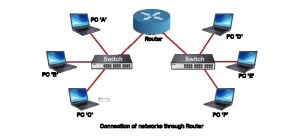30
Sep
Networking Technology with Switches and Routers: The Backbone of Modern Connectivity
In today’s fast-paced digital world, reliable networking is no longer a luxury—it’s a lifeline. Whether you’re streaming videos, attending online meetings, or managing large-scale enterprise operations, the ability to transmit data seamlessly and securely depends heavily on networking technology. At the heart of this technology lie two essential devices: switches and routers.
Understanding how switches and routers work—and how they work together—is key to grasping the fundamentals of computer networking. Let’s break it down.
What is Networking Technology?
Networking technology refers to the hardware, software, protocols, and infrastructure that enable devices to connect, communicate, and exchange data. It is the invisible thread that links computers, smartphones, servers, and other devices within a home, office, or across the world via the internet.
This technology is what powers everything from local area networks (LANs) to wide area networks (WANs), and makes applications like cloud computing, video conferencing, and online gaming possible.
Switches: The Traffic Directors of Local Networks
A switch is a device that connects multiple devices within a local network, such as computers, printers, and servers. Think of it as a local traffic cop directing data to the right destination within a building or office.
Key Functions of Switches:
-
Forwarding Data Packets: Switches receive data and send it only to the specific device it’s meant for, not the entire network.
-
Creating Network Efficiency: By reducing unnecessary data traffic, switches ensure faster and more efficient communication between devices.
-
MAC Address Learning: Switches keep a table of MAC addresses to know exactly where to send data.
Types of Switches:
-
Unmanaged Switches: Simple, plug-and-play devices used in small networks.
-
Managed Switches: Allow network configuration and monitoring, ideal for complex or enterprise-level networks.
Routers: The Gatekeepers to the Internet
While switches connect devices within a network, a router connects multiple networks together—especially your local network to the internet. It decides the best path for sending data between different networks.
Key Functions of Routers:
-
IP Address Management: Assigns IP addresses to devices in the network.
-
Routing Packets Between Networks: Directs data between your network and external networks (e.g., the internet).
-
Network Security: Often comes with firewalls and features that help protect against cyber threats.
Home vs Enterprise Routers:
-
Home Routers: Usually combine routing, switching, and wireless access into one device.
-
Enterprise Routers: More powerful and configurable, handling high-volume data and offering advanced security and redundancy.
Switches vs Routers: What’s the Difference?
| Feature | Switch | Router |
|---|---|---|
| Function | Connects devices in a local network | Connects different networks (e.g., LAN to WAN) |
| Layer | Operates at Data Link Layer (Layer 2) | Operates at Network Layer (Layer 3) |
| Address Type | Uses MAC addresses | Uses IP addresses |
| Data Direction | Forwards data within a network | Routes data between networks |
Why Are They Important Together?
Switches and routers often work hand-in-hand. In a typical setup:
-
The switch connects all your internal devices.
-
The router connects your local network to the internet.
-
Together, they allow devices to communicate internally and externally with maximum efficiency and security.
In large organizations, there may be multiple layers of switches and routers configured to support thousands of devices and ensure network stability, speed, and scalability.
Applications in the Real World
-
Business Networks: Large corporations use managed switches and high-performance routers to support internal operations, secure data, and connect with clients worldwide.
-
Education and Healthcare: Schools and hospitals rely on networking infrastructure to enable e-learning, telemedicine, and efficient data sharing.
-
Smart Homes: Routers with built-in switches enable connectivity for smart TVs, lights, security systems, and voice assistants.
Conclusion: Embracing the Backbone of Connectivity
Switches and routers are not just tech jargon—they are the unsung heroes behind everything we do online. As we enter an era dominated by cloud computing, IoT, remote work, and AI, understanding and investing in solid networking technology becomes more important than ever.
Whether you're setting up a home network, running a business, or planning for future infrastructure, switches and routers will be at the core of your digital journey.


